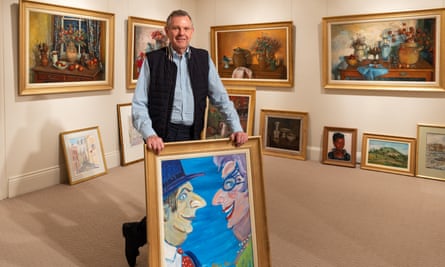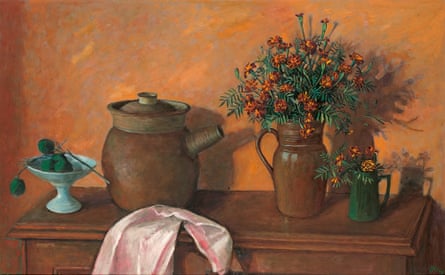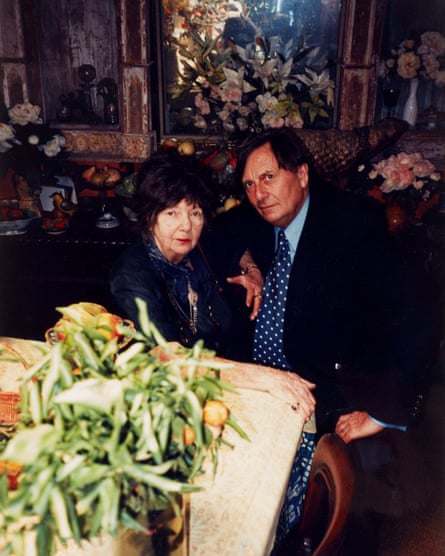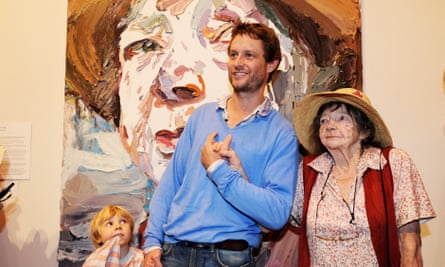The lunches at Margaret Olley’s Paddington terrace were legendary. Amid the bench tops overflowing with paint tubes, brushes, turpentine and still life objects, the Australian artist would conjure up “the most amazing meals from her teeny cave-like” kitchen, Brisbane art dealer Philip Bacon recalls, and upbraid her longsuffering housekeeper Poppy whenever she attempted to restore order.
“None of us knew why Poppy was there – because she certainly wasn’t allowed to clean,” Bacon recalls. “If Poppy touched anything, Margaret would remonstrate indignantly: ‘Don’t touch that Poppy, that’s a painting.’”
Some of Margaret Olley’s earliest works will go on sale as part of an exhibition in Brisbane next week, coinciding with the 100th anniversary of the Australian artist’s birth. Olley died in 2011, one month after her 88th birthday.
On the night of her death, she polished off a plate of Poppy’s treasured cauliflower au gratin, a bowl of her favourite dim sims from Edgecliff shopping centre, and a compulsory dessert cigarette (or two).
“Living with Margaret was hilarious, it was like living in a salon, people were coming and going all the time,” recalls Philippa Drynan, who was the artist’s housemate for the last six years of her life. “The only place to sit in the kitchen was a tiny stool, and there were shopping bags everywhere. Nothing ever got thrown out, she was an incurable hoarder.”

As co-executor of the Margaret Olley Trust, Bacon considers himself blessed to have shared so much of her topsy-turvy, overflowing life, which was characterised as much by her philanthropic generosity as her artistic output.
One of the works in the show opening next week, Marigolds and Limes, was sold at Bacon’s first Olley exhibition in 1975 for $925 (about $8,000 in today’s money). Today, it is valued at $95,000.
“She always felt that she should keep her prices relatively low,” Bacon recalls. “She was still doing a few for $1,000 in the mid-to-late 70s, and as other artists’ prices went up, she would love to say, ‘Oh, I sell frames and the paintings are for free.’”

Curating an exhibition that draws from almost every decade of Olley’s 70-year career has been a journey back in time for Bacon. He was a rookie art dealer when he met Olley in that famously chaotic Paddington house in the late 1960s. “We hit it off immediately, and from then on she was amazingly supportive,” he says.
But it took him almost a decade to convince the artist to show in his newly opened Philip Bacon Galleries in Fortitude Valley, which had already secured the business of Charles Blackman and Robert Dickerson. That first exhibition, in 1975, “was a total sellout, of course,” Bacon says. “She really was one of Australia’s best-loved and most sought-after artists.”

Other early works on show in Margaret Olley: 100 Years include watercolours from her first trips to Europe in the 1950s; a Brisbane streetscape from the 1960s; and a rare portrait, Sepik Woman, from her intrepid trip to Papua New Guinea in 1968.
In her lifetime, Olley staged more than 90 solo exhibitions, donated millions of dollars to the Art Gallery of NSW and the National Gallery of Australia for the purchase of other artists’ works, and championed some of the next generation’s leading artists, including Ben Quilty, Cressida Campbell and Nicholas Harding.
She was also a favourite subject of many of her contemporaries, with her portraits by Jeffrey Smart, Russell Drysdale and William Dobell, along with Quilty’s, etched in the public consciousness. Being a painter of still life and interiors herself, Olley never won the Archibald prize, but has the unique distinction of being the subject of an Archibald prize-winning portrait twice, with a 63-year span in between Dobell’s work of the young artist in straw hat and borrowed silk wedding gown, and Quilty’s gritty closeup, which won the same year as her death.

“I’m like an old tree dying and setting forth flowers as fast as it can, while it still can,” she told Quilty, of her prolific output which continued to the very end.
As Bacon prepares for next week’s opening, he is in mourning for another close friend, Barry Humphries, of whose trust the gallerist is also an executor. When Olley and Humphries were both named among Australia’s original 100 living treasures by the National Trust in 1997, Bacon had known the pair, who were close friends, for three decades.
And of the many Olley exhibitions Bacon mounted in London over the years, Humphries was invariably on hand to open them. “Barry was a big star [in London] and he would always do a wonderful poem or something for Margaret, and people would come out in their droves for an opening. They might never have heard of Margaret Olley but they’d certainly heard of Dame Edna Everage.”

Olley was a woman who demanded of others no more than she would demand from herself, which was considerable, Bacon recalls. She fought and won a battle with alcoholism – she was fond of describing herself as a “nonpractising alcoholic” – and supported Humphries in his path towards sobriety. She scolded Quilty for his “ugly” paintings exploring themes of addiction, masculinity and politics and pleaded with him to start painting something “beautiful”.
“She disapproved of a lot of Ben’s angst-ridden, ‘ugly’ paintings and used to say to him, ‘You’ve got to stop that, you can’t save the world,’” Bacon recalls. “Well, Ben didn’t stop it but that never affected their friendship.”
“Margaret could be pretty tough on people, she would never take the easy way conversationally … and her political views could be quite rightwing,” says Bacon.
“She didn’t approve of government handouts at all, she didn’t expect to be helped by government and didn’t see why anyone else should be. But then she was happy to help younger artists where she could and that’s where her marvellous philanthropy came in.”
Olley would buy up works from young unknown Australian artists such as Campbell and Harding and over the years became a munificent benefactor, with her cash donations enabling the AGNSW and the NGA to acquire works by Degas, Cézanne, Freud, Matisse, Picasso and her own favourite still life master Giorgio Morandi.

The millions of dollars given away were more likely to have come from her savvy property deals than through her art sales. For a youngish single woman with an erratic income, Olley acquired an impressive property portfolio in Newcastle; according to Bacon, she managed to secure loans by bank-hopping along Hunter Street, securing a mortgage for one property from one bank in the morning, and another for a different property from a different bank after lunch.
Yet she lived frugally. Art – making it and buying others’ – was her only extravagance.
“It’s what she lived for, and what she died doing,” says Bacon. There were several unfinished works in her Paddington Terrace the night she died in her sleep, on 26 July 2011.
“Her legacy will live on, of course, through her generosity,” says Bacon. “But what history will remember best is her life-affirming paintings, full of colour, joy and love.”
Margaret Olley: 100 Years opens at Philip Bacon Gallery, Brisbane on 20 June and runs until 15 July.
https://news.google.com/rss/articles/CBMiiwFodHRwczovL3d3dy50aGVndWFyZGlhbi5jb20vYXJ0YW5kZGVzaWduLzIwMjMvanVuLzE3L3RoZS1jaGFvcy1nZW5lcm9zaXR5LWFuZC1nZW5pdXMtb2YtbWFyZ2FyZXQtb2xsZXktb25lLW9mLWF1c3RyYWxpYXMtYmVzdC1sb3ZlZC1hcnRpc3Rz0gEA?oc=5
2023-06-16 15:31:00Z
CBMiiwFodHRwczovL3d3dy50aGVndWFyZGlhbi5jb20vYXJ0YW5kZGVzaWduLzIwMjMvanVuLzE3L3RoZS1jaGFvcy1nZW5lcm9zaXR5LWFuZC1nZW5pdXMtb2YtbWFyZ2FyZXQtb2xsZXktb25lLW9mLWF1c3RyYWxpYXMtYmVzdC1sb3ZlZC1hcnRpc3Rz0gEA
Tidak ada komentar:
Posting Komentar